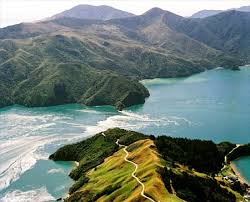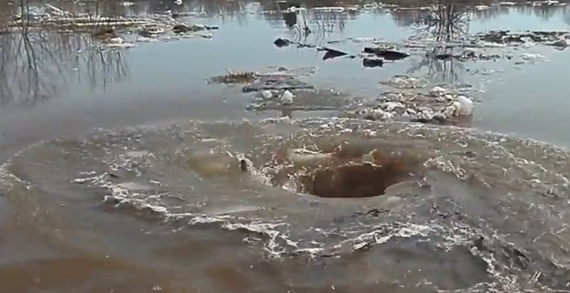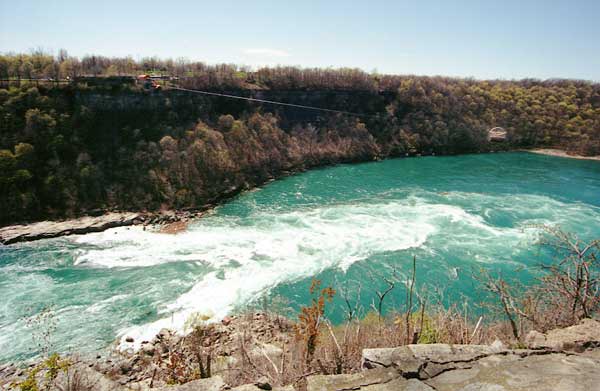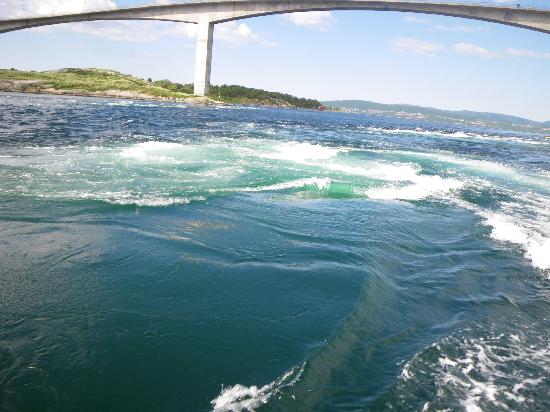The whirlpool is a natural phenomenon much loved by myth-makers and authors. In novels by Jules Verne and Edgar Allen Poe whirlpools are capable of swallowing whole ships whole but in reality, whirlpools aren’t that powerful. Still, there are an awesome sight and there are a few places in the world where you can get close enough to observe them in action. They’re remote and hard to get to, but if you’re prepared for a bit of a hike check out our Top 10 Places to See Whirlpools.
10. Naruto, Japan

It’s just as well that whirlpools don’t actually swallow ships whole, because you can take a cruise along the Naruto Straight to see the whirlpools off the Shikoku coast of Japan. With typical Japanese whimsy, the boats are known as the “Aqua Eddy” and the “Wonder Naruto” – the Wonder is a large boat which gives great views of the whirlpools below. But if you don’t fancy taking your chances on a boat, you can also see them from the Uzu no Michi walkway, suspended below the Onaruto Bridge, which has windows in the base 45m above the pools. They only occur every 6 hours or so, and are bigger in summer than winter so it’s worth planning a visit for a time when the pools are going to be most dramatic!
9. Old Sow, USA/Canada

There’s something worrying about an tourist attraction that has a survivors’ club. Old Sow is a giant whirlpool that lies between the USA and Canada, near Deer Island, New Brunswick on the Canada side and Eastport, Maine on the American. It can be viewed from land from Deer Island, but “The Few, The Brave, The Swirled” can take a boat ride under supervision to the 76-m wide vortex and claim their certificate from the survivors’ club afterwards. And for those who are really interested, there are a number of other tidal features in the area, such as tidal bores and thunder holes, as well as some smaller whirlpools known as the “Piglets”. It’s hard to measure Old Sow herself, but it is reckoned to be the biggest whirlpool in the Western Hemisphere!
8. Moskstraumen, Norway

If you wondered where Edgar Allen Poe and Jules Verne got their inspiration from, you don’t need to look much further than this series of whirlpools in Lofoten, Norway. Both “A Descent into the Maelström” and “Twenty Thousand Leagues Under the Sea” featured a whirlpool in the vicinity of Moskstraumen. The reason it became legendary is that it truly is a dangerous part of the sea, and visitors are advised not to try and fish the waters for themselves. It is also one of the only whirlpools to be out in the open sea, rather than in a strait or river and so it is one of the hardest to see. However, locals still take fishing boats out in the direction of Moskstraumen, and there are tourist “Adventure Boat” tours that go out there too, so it is possible to observe the legendary waters at close range. Probably not one for anyone who suffers with sea-sickness, thanks to the unpredictable nature of the waters!
7. Corryvreckan, Scotland

One whirlpool that does lie in a channel is the Corryvreckan whirlpool, between the islands of Jura and Scarba, off the coast of Scotland. The channel is defined as impossible to navigate by the Royal Navy, but that doesn’t stop wild swimmers and sailors trying to get close to it. As with other whirlpools, it varies in strength, with 10-knot currents occurring at times. It also has a literary connection, as author George Orwell wrote “1984” on Jura and had to be rescued from the whirlpool in 1947, after his boat got caught up in the whirling waters. If you fancy following in George’s footsteps, there are boat trips to see the pool, but it can also be spotted from the northern tip of Jura – probably the safest option, given how many sailors have drowned in the channel.
6. Charybdis, Italy

From a legendary whirlpool to a mythical one. Charybdis was a sea creature in Greek mythology, that lived in the Straits of Messina and devoured ships as they passed. Later on, the blame for the ship-devouring passed to a genuine whirlpool in the area, although the whirlpool is fairly mild and hasn’t been known to swallow any ships in recent memory. It is now known as Garofalo and can be seen from the coast of Sicily. It’s not the most dramatic whirlpool, but the mythology attached to it makes it an interesting place to visit for classics scholars. Just beware of sea monsters – even if you avoid Charybdis, there’s always the six-headed monster Skylla on the other side to do the devouring!
5. Skookumchuck Narrows, Canada

This series of rapids has an entire National Park around it and it’s a great place for outdoor pursuits, like walking, scuba diving and camping. However, the whirlpools themselves are not for the amateur canoeist – the website advises to check the tides before you go and only cross the rapids at high tide or low slack tides. At other times, the whirlpools and whitewater can be hugely dangerous. It’s safer all round to see the rapids from the specially built viewing platforms at the water’s edge and to combine it with a hike around the wild beauty of the park. Just a note for anyone of a delicate constitution – the park only has pit toilets, not flush ones. You really will get a sense of what life is like in the wild!
4. Te Aumiti, New Zealand

This next whirlpool is spectacularly beautiful, but also spectacularly dangerous. Official advice says that you should only sail through at slack tide, which lasts around 20 minutes, because of the difficulty in steering and the risk of meeting other ships coming in the other direction. Te Aumiti lies between Admiralty Bay and Tasman Bay and the tides from each flow into a basin, known as Current Basin, causing the whirlpools in what is also known as French Pass (this name was given to the stream by French explorer Dumont D’Urville, who successfully navigated the pass in 1827). On one side of the stream is the island of Rangitoto ki te Tonga, which is also known as D’Urville Island after the explorer. It’s largely undeveloped, so good for hiking and see the native forest, which is home to tui, bellbirds, weka and kaka. You can get there by water taxi from the mainland, and it’s a good vantage point to see the rushing waters of Te Aumiti for yourself.
3. Dviete, Latvia

Now, this is one whirlpool that might just justify the reputation that whirlpools have. The vortex in Latvia hit headlines earlier this year, with claims that the “Monstrous whirlpool…swallows everything in its path” and there is, in fact video evidence that the whirlpool is capable of taking down chunks of ice and bits of floatsam and jetsam that was drifting along the Daugava River. Still, it has so far failed to swallow any humans whole, or even a cow so it’s not quite as exciting as everyone made it out to be. Apparently anything that goes into the whirlpool ends up under the road next to the river, where the video was filmed from. So if you happen to visit, and you hear something mooing beneath your feet, you’ll know that the monstrous whirlpool has finally taken a bovine victim.
2. Niagara Falls

You’d expect the mecca for all things water-y to have its own whirlpool, wouldn’t you? And you wouldn’t be disappointed, with the rushing waters of the falls providing the perfect conditions for a whirlpool. You can see them it a special Aero Car, which glides over the Great Gorge, giving you a perfect, if terrifying, view. The Aero Car was built in 1916 by renowned Spanish engineer Leonardo Torres Quevedo and has been upgraded three times since, but it’s still an authentically vintage experience. The ride lasts for around 10 minutes and covers a distance of 1km and is definitely the safest way of getting close to the roaring whirlpool of Niagara!
1. Saltstraumen, Norway

And now for the world’s most powerful whirlpool – Saltstraumen in Norway. Known as a maelstrom (a Nordic word for whirlpool), the pool is 10metres wide and 5metres deep and caused by the 400million cubic metres rushing through a narrow channel every 6 hours. It’s obviously dangerous for sailors, and it is essential to check tide timetables before setting out as it’s very easy to get into trouble. Even when all seems calm on the surface, there are currents underneath that can pull boats down. The maelstrom can be found near the town of Bodø, which is just north of the Arctic Circle and so has a short period each year where you can see the midnight sun. It’s also pretty cold, so if you even attempt to sail near Saltstraumen make sure you’re wearing thermals! But it might just be worth it to see the world’s strongest maelstrom in action. An awesome sight, and one to be treated with respect.